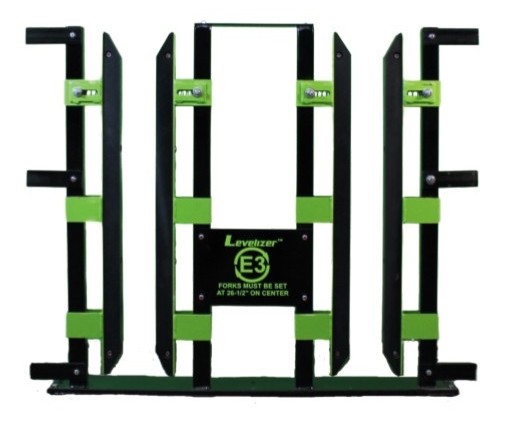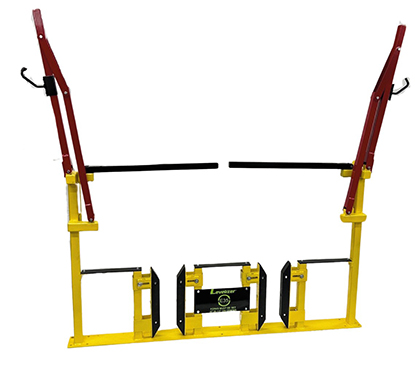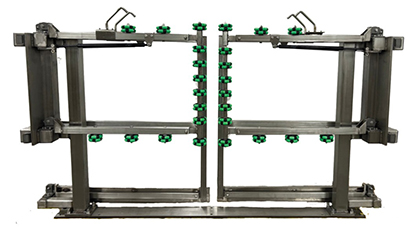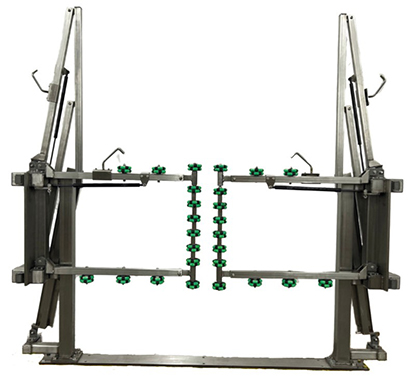Mezzanines are a staple in modern industrial facilities, offering a practical solution for maximizing vertical space in warehouses, distribution centers, and manufacturing plants. These elevated platforms enable businesses to store inventory, house equipment, or create additional workspaces without expanding their footprint. However, with this added utility comes an inherent risk: falls from height. According to the Occupational Safety and Health Administration (OSHA), falls remain one of the leading causes of workplace injuries and fatalities, with over 300 non-construction workers losing their lives in 2021 due to falls to a lower level. For facility safety managers, ensuring mezzanine safety is a legal and ethical imperative.
Central to this effort are mezzanine safety gates, which are engineered solutions designed to protect workers from fall hazards while facilitating the movement of materials. These gates are critical components in complying with OSHA regulations and aligning with voluntary American National Standards Institute (ANSI) guidelines. Let’s explore how mezzanine safety gates address fall protection requirements, the standards that govern their use, and their broader impact on workplace safety.
Understanding the Risks of Mezzanines
Mezzanines often feature open edges or pallet drop areas where materials are loaded and unloaded, typically via forklifts or cranes. These openings, while essential for workflow, create significant fall risks. OSHA data highlights that fall protection violations consistently rank among the agency’s most frequently cited issues, underscoring the urgency of addressing these hazards. A fall from a mezzanine, often four feet or higher, can lead to severe injuries. Workers’ compensation claims an average of over $36,000 per incident, while fatalities can cost companies more than $1.4 million in direct and indirect expenses.
The challenge lies in balancing safety with productivity. Traditional solutions, such as removable railings or swing gates, require manual operation, introducing human error into the equation. A gate left open or a railing not replaced after material handling can render a facility non-compliant and expose workers to danger. This is where purpose-built mezzanine safety gates come into play, offering a seamless integration of safety and efficiency.

Figure 1. A mezzanine safety gate system where you can deliver materials to the mezzanine without opening a gate, ensuring continuous fall protection during material handling.
OSHA Standards: The Legal Backbone of Fall Protection
OSHA sets the baseline for workplace safety in the United States, and its regulations are mandatory for employers. For mezzanines, the key standard is found in 29 CFR 1910 Subpart D, "Walking-Working Surfaces." Specifically, Section 1910.28(b)(1)(i) mandates that any unprotected side or edge of a walking-working surface four feet or more above a lower level must be protected by a guardrail system, safety net system, or personal fall protection system (e.g., harnesses or restraints). For mezzanines with pallet drop zones, this requirement ensures protection is in place when the area is not actively in use for material transfer.
Section 1910.29 further details the criteria for guardrail systems, stipulating that the top rail must be 42 inches above the walking surface (plus or minus 3 inches) and capable of withstanding a 200-pound force in any downward or outward direction. Additionally, a mid-rail or equivalent must be present, and toeboards are required if there is a risk of objects falling to the level below. Single-gate systems, such as swinging or sliding gates, meet these requirements only when closed—a critical limitation, as an open gate during loading leaves the edge unprotected, violating OSHA’s mandate for continuous protection.
Dual-gate safety systems address this gap. These designs feature two interconnected gates: when one opens to allow material access, the other remains closed, maintaining a constant barrier. This configuration aligns with OSHA’s intent by eliminating reliance on worker action to restore protection, reducing the risk of oversight or delay.
 
Figure 2. The Dual Gate Mezzanine safety gate system ensures continuous fall protection during material delivery and handling.
ANSI Standards: The Voluntary Best Practices
While OSHA provides enforceable minimums, ANSI standards offer a voluntary framework that often exceeds these requirements, reflecting industry best practices. For mezzanines, ANSI MH28.3-2009, "Design, Testing, and Utilization of Industrial Steel Work Platforms," addresses safety gates explicitly. Section 6.4.3 recommends that pallet drop areas be secured with gates that ensure worker protection during loading and unloading, advocating for designs like dual-gate systems to prevent falls.
Additionally, ANSI/ASSE Z359.1, part of the Z359 Fall Protection Code, sets rigorous standards for fall protection equipment, including anchorage points and connectors often integrated into mezzanine safety systems. Though not legally binding, ANSI standards are widely regarded as the gold standard, influencing product design and employer policies. Compliance with ANSI can also bolster a facility’s defense in liability cases, demonstrating a commitment to exceeding basic requirements.
The Practical Advantages of Mezzanine Safety Gates
Beyond compliance, mezzanine safety gates deliver tangible benefits. Dual-gate systems, for instance, streamline workflows by eliminating the need to manually secure openings, saving time and reducing physical strain on workers. They also mitigate the risk of falling objects—a secondary hazard addressed by OSHA 1910.28(b)(1)(ii)—when paired with toeboards or netting.
Consider a typical warehouse scenario: a forklift operator delivers a pallet to the mezzanine edge. With a dual-gate system, the outer gate opens to receive the load while the inner gate remains closed, protecting workers on the platform. Once the pallet is in place, the gates reverse positions, allowing safe access to the material without ever exposing the edge. This choreography of safety and efficiency is a hallmark of modern gate designs.
 
Figure 3. The Dual Gate Mezzanine safety gate system ensures continuous fall protection during material delivery and handling.
Implementation Considerations
Facility managers evaluating safety gates should prioritize designs that meet both OSHA and ANSI specifications. Key features to look for include:
Height and Strength: Top rails at 42 inches and capable of withstanding 200 pounds of force.
Continuous Protection: Dual-gate mechanisms or self-closing features to eliminate unprotected moments.
Durability: Materials like powder-coated steel to withstand industrial environments.
Customization: Options to fit standard or unique mezzanine layouts, such as wide pallet drop zones.
Regular inspections and maintenance are also critical. OSHA 1910.29 mandates that guardrail systems remain in good condition, while ANSI Z359.7 recommends periodic testing of fall protection components. A proactive maintenance schedule ensures long-term compliance and safety.
The Bigger Picture: A Culture of Safety
Investing in mezzanine safety gates is more than a regulatory checkbox—it’s a step toward fostering a safety-first culture. The National Emphasis Program on Falls, launched by OSHA in 2023, underscores the agency’s renewed focus on reducing fall-related incidents. By adopting solutions that align with both OSHA mandates and ANSI’s higher standards, facilities signal their commitment to worker well-being, potentially lowering insurance costs and enhancing employee morale.
Conclusion
Mezzanine safety gates are a linchpin in the fight against workplace falls, bridging the gap between OSHA’s legal requirements and ANSI’s aspirational standards. They offer a practical, compliant solution that protects workers without sacrificing efficiency—a win-win for facility managers navigating the complexities of industrial safety. As fall hazards persist, these gates stand as a testament to the power of engineered solutions in safeguarding lives and livelihoods
References
Occupational Safety and Health Administration (OSHA). 29 CFR 1910 Subpart D - Walking-Working Surfaces. Available at: www.osha.gov.
ANSI MH28.3-2009. Design, Testing, and Utilization of Industrial Steel Work Platforms. American National Standards Institute.
ANSI/ASSE Z359.1-2016. Safety Requirements for Personal Fall Arrest Systems, Subsystems, and Components. American National Standards Institute.
OSHA National Emphasis Program on Falls, 2023. Available at: www.osha.gov
|
